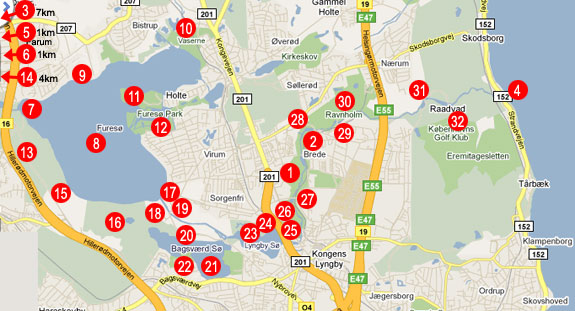Millstream and its Lakes (Mølleåen og dens Søer) – Activities 1

1. Frilands Museum (Frilandsmuseet). The Frilands Museum (Frilandsmuseet) is a very impressive open air museum which is dedicated to preserving the memory of what life was like in the area during before the 20th century. All of the houses, farms and mills associated with this museum, have been moved from their original locations throughout Denmark, and they have been rebuilt piece by piece at the museum. The buildings are from the period 1650-1900, and the interior of the buildings give a great overview as to how people lived at the time. The museum is open from April to October. Free entrance on Wednesdays.
2. Brede Work (Brede Værk). The former mill ‘Brede Work’ (Brede Værk) is used today as a museum. The original mill was built in 1370. In 1628 the mill was turned into a producer of gunpowder. From 1668-1855 the mill produced copper. From 1831-1956 there was a section of the mill which produced clothing. The addition of clothing section of the factory had the effect that a small community grew up around the area. Around the 19th century 600 people lived here. The village had a local grocer's, school and a pub/eating facility. The museum tells the story about the industrialisation along the Millstream. The museum also has a huge collection of the clothing which displays the changing styles in Denmark over 4 centuries.
3. Bastrup Lake (Bastrup Sø). On the northside of the lake you’ll find the ruins of the Bastrup Tower (Bastrup Tårnet).
4. The Beach Mill (Strandmøllen). The Beach Mill (Strandmøllen) was built in 1599. In 1776 several homes were built in the area for the 50 or so people who worked in the mill. The Drewsen family owned the mill for almost 200 years. In 1821 the first privately owned steam engine was installed in the mill. In 1829 the first paper machine in Denmark was installed.
5. Farum Farm (Farumgård). This white building from 1705 is beautifully facing the lake east from Farum Church (Farum Kirke). It’s allowed to walk through the farm and park through a path, which is a part of the path system all the way around Farum Lake (Farum Sø).
6. Farum Lake (Farum Sø). This 15 meters deep lake has a 120-hectare water area, and is connected to Fure Lake (Furesø). There’s boat rental by the lake phone number +45 44 95 47 16.
7. Fure Lake Bath (Furesøbad). Is a man made beach with wooden piers. Nearby is Fiskebæk Nature School (Fiskebæk Natur Skole) that exhibits the animals and flora in the lake. They also arrange guided nature trips phone number +45 44 95 08 95.
8. Fure Lake (Furesø). This clean lake is 38 meters deep and it’s the deepest lake in Denmark. The lake contains 127 millions m3 water. The circumference of the lake is 19 kilometres. It’s allowed to fish with a fishing license in the lake. You can buy a fishing license at any Post Office in Denmark.
Millstream (Copenhagen): Tourist Attractions (Part 1)
Millstream (Copenhagen): Tourist Attractions (Part 2)
Millstream (Copenhagen): Tourist Attractions (Part 3)
Millstream (Copenhagen): Tourist Attractions (Part 4)
See Also:
Central Copenhagen (København) - Main Page
Christianshavn (Copenhagen)
Millstream and its Lakes (Mølleåen og dens Søer) (Copenhagen)
LastUpdate: 2016-10-10 11:42:08
